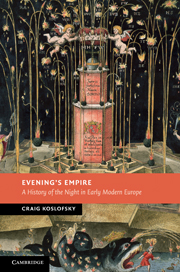Book contents
- Frontmatter
- Contents
- Figures
- Maps
- Acknowledgments
- Chapter One An early modern revolution
- Chapter Two Darkness and the Devil, 1450–1650
- Chapter Three Seeking the Lord in the night, 1530–1650
- Chapter Four Princes of darkness: the night at court, 1600–1750
- Chapter Five “An entirely new contrivance”: the rise of street lighting, 1660–1700
- Chapter Six Colonizing the urban night: resistance, gender, and the public sphere
- Chapter Seven Colonizing the rural night?
- Chapter Eight Darkness and Enlightenment
- Chapter Nine Conclusion
- Notes
- Bibliography
- Index
Chapter Three - Seeking the Lord in the night, 1530–1650
Published online by Cambridge University Press: 05 August 2013
- Frontmatter
- Contents
- Figures
- Maps
- Acknowledgments
- Chapter One An early modern revolution
- Chapter Two Darkness and the Devil, 1450–1650
- Chapter Three Seeking the Lord in the night, 1530–1650
- Chapter Four Princes of darkness: the night at court, 1600–1750
- Chapter Five “An entirely new contrivance”: the rise of street lighting, 1660–1700
- Chapter Six Colonizing the urban night: resistance, gender, and the public sphere
- Chapter Seven Colonizing the rural night?
- Chapter Eight Darkness and Enlightenment
- Chapter Nine Conclusion
- Notes
- Bibliography
- Index
Summary
Discovering the night
In the fiery exchanges of the first decades of the Reformation all sides cast their struggle as one of light against darkness, Christ against Antichrist. This was the world of the witch persecutions as well. Loud accusations of spiritual darkness or benighted ignorance drowned out the quieter tones that occasionally described darkness and the night as a path to the Divine. Yet by the end of the sixteenth century, a very different sense of darkness and the night emerged in Christian visual culture, spirituality, and literature. The art historian Maria Rzepinska was one of the first to call attention to the “‘discovery of darkness’ or the ‘discovery of night’” in European Christian culture at the very end of the sixteenth century. She examined the use of “active darkness” to create shafts of artificial, condensed light in baroque painting, especially in the works of the late Tintoretto, Caravaggio, Ribera, Honthorst, and Georges de La Tour. The use of this intense chiaroscuro suggested to Rzepinska “a powerful European trend which introduced darkness, inseparable from light, as an iconic and psychological factor of essential significance.” In similar terms, Chris Fitter has documented the rise of the poetic nocturne in the English Renaissance, whose “poetry, masques and painting, in revaluing the night as a time of beauty and profundity, overturn … the construction predominant in classical and medieval traditions.” Fitter also dates the earliest evidence of this “nocturnal revolution” to the end of the sixteenth century. The work of Rzepinska and Fitter on this “discovery of night” sought to contextualize the development in relation to European painting and English literature respectively, but their studies lead us to a broader question: how did early modern Europeans use the night to think about God in the turbulent period between the Reformation and the Enlightenment?
In this chapter I explore evidence of changing attitudes toward the night in the piety and practices of the Anabaptist movement, in the mystic theology of John of the Cross (1542–91) and Carmelite reform, and in the theosophy of Jacob Böhme (1575–1624). I then show how a wide range of writers across confessions, including John Donne (1572–1631), Johann Arndt (1555–1621), and Claude Hopil (c. 1580–after 1630) used the night in ascetic, apophatic, mystic, and epistemological terms as a powerful metaphor in the first half of the seventeenth century. This approach allows us to understand the uses of the night in early modern culture in terms more precise and revealing than those of previous scholarship and go beyond the general contrast between a positive night and a negative night.
- Type
- Chapter
- Information
- Evening's EmpireA History of the Night in Early Modern Europe, pp. 46 - 90Publisher: Cambridge University PressPrint publication year: 2011



